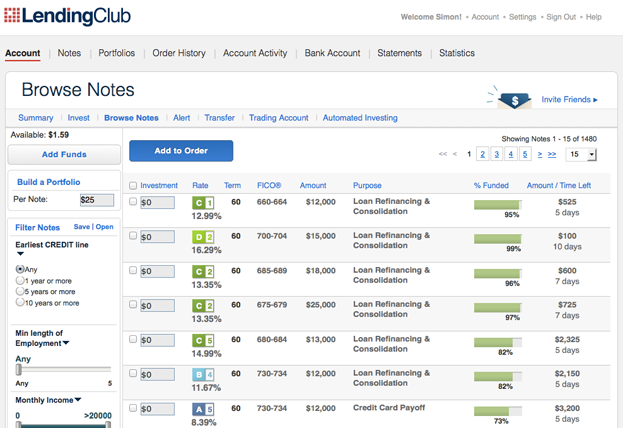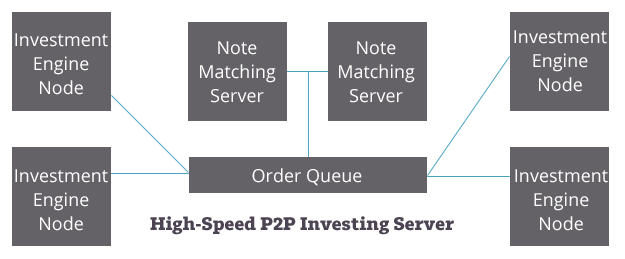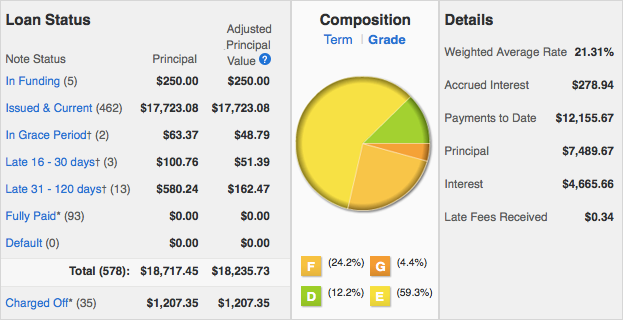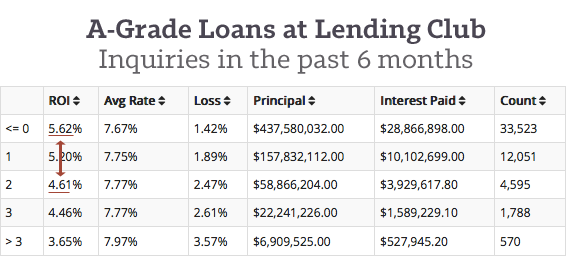When I began peer to peer lending in 2011, I began with B through D-grade notes at Lending Club, and barely read the details of each loan. Years later, I see now that they actually designed their site to encourage investors to do exactly that.
Similar to today, Lending Club’s website mostly encouraged me to simply amass quantity. Each loan’s credit variables were available to inspect, but were complicated enough that I got dizzy and just moved on with my day. I scrutinized perhaps 5-10 of the loan descriptions in my original 200 notes. And Lending Club was right; their underwriting was solid, and I earned a remarkable return. Investing in a few hundred notes is what mattered.
For beginners, this remains a great initial tack to embrace: just invest in 200 of any of the available loans. Try not to get bogged down in terms like ‘debt-to-income ratio’. Instead, trust Lending Club or Prosper’s borrower standards. By treating every loan the same, you keep peer to peer lending the simple and worthwhile investment that it is.
However, I soon realized this anecdote wasn’t completely true. Every loan is not the same. In fact, there are hundreds of different loans issued each day, and the selection is actually very diverse.
The Opportunity for Arbitrage in P2P Lending
I realized this when I began to filter Lending Club’s available loans for those that had best historical performance. Sites like NickelSteamroller had taken Lending Club’s historical loan data, broken it down by various factors, and discovered that certain credit factors had better repayment history than others.
For instance, in the borrowers with an income over $60,000 per year were a better investment than those who earned less than $60,000 per year, and this income-advantage held true across all loan grades. Even the safest A-grade borrowers had $60K+ earners paying their loans back more frequently. Other solid factors to pursue were borrowers with zero previous credit inquiries (see below), or borrowers who were not using their loan towards a small business. In fact, there were numerous filters that had statistically higher returns despite having similar loan grades. And despite the benefit being quite small at times, the power of compound interest makes the practice worthwhile if done over time (see this video for an intro on filtering).
The financial term for this practice is ‘arbitrage’. Yes, like the movie with Richard Gere. It means taking advantage of the mismatch between how Lending Club grades their loans and how they might actually perform.
I began to pursue these mispriced loans for the slight bump it offered to my overall return. However, when I logged onto the platform to find them, only a few of the available loans met my filter. So I began to log on whenever Lending Club added large batches of new loans that hadn’t been picked over by investors. They did this every day at 6am, 10am, 2pm, and 6pm, so I set an alarm and logged on.

Available loans at LendingClub.com
It was here that I realized I was not alone. As I tried to invest during these feeding-times, many of the choice loans I sought would instantly be 100% funded without me. I would momentarily see them, many as large as $35,000, and try to invest just $25. Sometimes I succeeded. But often they would fully fund and vanish before I could act; $35,000 loans, gone in seconds. And it happened again and again.
I discovered a small feeding frenzy for choice loans beneath the calm of Lending Club and Prosper’s websites, and 95% of peer to peer lenders are completely unaware this is happening.
Gone in Milliseconds: The Hidden World of API Investing
I began to research how investors were doing this in the online forums. How are some investors able to both find and fund $35,000 loans before my web browser could even get the page loaded?
 The answer was — they weren’t using a browser. The quickest investors were actually using high-speed investing servers to auto-submit their orders. Their orders were being submitted over API commands that Lending Club had made available, which basically meant these people are investing through pure server code. No graphics. No Google Chrome. Just bare-bones lightning-fast ones and zeros picking up anything that matched their filters. No wonder I was losing.
The answer was — they weren’t using a browser. The quickest investors were actually using high-speed investing servers to auto-submit their orders. Their orders were being submitted over API commands that Lending Club had made available, which basically meant these people are investing through pure server code. No graphics. No Google Chrome. Just bare-bones lightning-fast ones and zeros picking up anything that matched their filters. No wonder I was losing.
Who would be interested in going to such lengths, setting up purpose-built servers with the goal to snag loans that might return just 1% extra? Big-dollar investors would, individuals and groups who have hundreds of thousands of dollars to put to work. Similar to high-speed investing on the stock market, many large financial groups have purpose-built high-speed peer to peer lending servers set up with the goal to be first in line in order to pick over Lending Club and Prosper’s newly added batches of loans before anybody else.
My Interview with a High-Speed P2P Investing Server Operator
I reached out to my various connections with the peer to peer lending community for someone who would be willing to talk about their role as an operator of one of these servers. Despite knowing a half-dozen of them, none were willing to go on record for this article, the two big reasons being (1) not wanting to increase competition in an already crowded space, or (2) remaining sensitive to their client’s wishes to stay off the radar. However, one operator was willing to talk as long as his identity would not be published.
How much money have you invested through your API server in the past year?
In the past twelve months, my setup has facilitated over $15 million worth.
Describe the physical setup of these high-speed servers.
The machines are quad-core AMD. They are located in a data center “close” to Lending Club’s server farm in Nevada, though not co-located.

How are you able to invest in loans so quickly?
Through a small cluster of a few midsized virtual machines running a console-only Windows Server. These clustered machines operate as investment engine nodes. They sit and listen for investment requests which get sent by two other VMs that are constantly listening and matching note selection. Once there is a loan that is identified for order generation, a message request gets generated and distributed to a message queue which is subscribed to and consumed by one of the investment engine nodes.
Beat the Herd: How to Begin Auto-Investing over API
Perhaps you’re one of those svelte people who understand that last paragraph. If that’s the case, you may want to head over to Lending Club and request your own API access so as to build your own rig. Some have done this over at the Lend Academy forum. A few of the statistically-gifted have even built rigs that submit orders using their own algorithm/credit-model, giving them an even better opportunity for arbitrage. But for the rest of us, there are actually a large number of third-party sites out there that allow high-speed investing with simple filtering.
Third-party peer to peer investor servers
Here are the two sites that I am aware of, though there may be others:
I have not used these sites for my own investing, but I know many have found them to be of great use (see PSL’s videos). By setting up an account on these sites, you are able to have (nearly) the same high-speed setup as big-dollar API investors.
have not used these sites for my own investing, but I know many have found them to be of great use (see PSL’s videos). By setting up an account on these sites, you are able to have (nearly) the same high-speed setup as big-dollar API investors.
The Fruits of API Investing: My Average Grade is E
I have personally been using a third-party API investing server for quite some time, specifically through NSR’s comparable tool. One of the strategies I employ is to invest in the riskier loans at Lending Club and Prosper. Here’s my IRA at Lending Club:

As you can see, my average loan is E-grade (same for my Prosper account). And almost 30% of my investment is held in the rarer F and G-grades. The riskier graded loans are often quite scarce at Lending Club and Prosper, particularly if you filter them like I do. They are among the more popular loans the platforms offer. And it is partly through using API auto-investing that I have been first in line, able to amass a portfolio of custom-filtered low-grade loans that returns over 11% [Note: my personal approach is quite risky].
The Likely Future of High-Speed P2P Investing
Both Lending Club and Prosper are acutely aware of all this. After all, they built the API interface these investor servers use, because doing so allowed their larger customers to stay better invested, the result being a more consistent stream of borrower funding and a more stable platform for everybody involved.
However, the platforms are equally aware that the race to shave off milliseconds through locating your server near their location introduces advantages for the wealthiest investors. On multiple occasions, Lending Club’s management has emphasized their goal to maintain an “equal playing field”. Prosper did this too when they helpfully introduced a 10% max-investment cap per investor. In short, the platforms continue to adjust the API each year with a overall goal to keep it on par with web-browser investing.
 For example, Lending Club’s ‘Automated Investing’ tool on their regular website has become more worthwhile of an option with each passing month. In a boon for average retail investors, it seems to pick up even low-grade loans with fair consistency, and Lending Club deserves great praise for making this happen. However, the tool does not allow the tight filtering or feeding-time submits that custom API servers allow.
For example, Lending Club’s ‘Automated Investing’ tool on their regular website has become more worthwhile of an option with each passing month. In a boon for average retail investors, it seems to pick up even low-grade loans with fair consistency, and Lending Club deserves great praise for making this happen. However, the tool does not allow the tight filtering or feeding-time submits that custom API servers allow.
It seems that, for the time being, smaller-dollar investors do indeed gain an advantage if they mimic the investing practices of bigger-dollar investors. Thankfully, the cheapness of computer servers and the generosity of sites like Lending Robot make this a realistic option for almost anybody who wants it.
[image credit: Beraldo Leal “Data Center – NCC” CC-BY 2.0]


Another great piece Simon. From what I have heard the platforms have put in speed bumps to make the playing field more level and so these high speed investors can’t bombard the servers of LC and Prosper thousands of times a second. I think this has helped maintain a more level playing field between the API investors and the regular retail investors.
Thanks Peter. I really appreciate how these companies have a value in keeping things somewhat fair.
BV FAQ: BlueVestment is currently closed to new users. Current existing users will be supported.
I just rechecked and they are indeed still open.
A brilliant article, the API would certainly be welcome in the UK by the wealthier and corporate investors, the tool is utilised by some UK listed funds now. We are the only platform on the UK providing riskier loans in the UK and all are fully funded at approval stage. The API route I fear woul squeeze the little guy out, but it’s something we accept is an unintednded consequence of P2P lending phenomenal success.
Great article. Reading it reminded me of the arms race in high speed stock trading. Where companies spend hundreds of millions of dollars on dedicated fiber lines between cities to shave off milliseconds on a trade. Or even bore holes directly to the city instead of worrying about the curvature of the earth.
http://www.wired.com/2012/08/ff_wallstreet_trading/all/
Sounds like P2P Lending is doing the same thing with servers closer to LC’s and dedicated API machines.
Great link JJ! Thanks for sharing.
Cool article. Though I think arbitrage requires that you sell one product. Simply picking what you perceive to be better loans is not really arb. Arb would be if you were to sell the lower ones and use the proceeds to buy the better ones. Something like interest rate arb requires the selling of one instrument to fund the purchase of another. Not simply buying the one with a higher return. Possibly semantics, though important.
Good point. Through my conversations with financial experts more knowledgeable than myself, I feel comfortable calling this arbitrage, but I think your comment is a good challenge to that classification.
This is an easy issue to settle: http://dictionary.reference.com/browse/arbitrage
Over-engineering again?!
Are these guys really worrying about milliseconds? My initial tests on the LC platform API several months ago of loan availability showed time for the opportunity to act of seconds in the worst case (and usually a lot longer than that – tens of seconds? a couple minutes?). Clearly, a lot of this is still too fast for anyone competing manually over a browser. However, the setup described seems completely over the top. An AWS ‘micro’ instance on the east coast, and an not-optimized-for-speed PHP script a few hundred lines long manages my significant sized portfolio without issue, i.e. the amount I want to invest in a loan is almost always what I get so they are not filling up between the time I get the latest loans and manage to shoot out the request.
Now, one might argue that I’m missing the chunk of the loan batch that gets scooped up within milliseconds of release. This is possible, and I haven’t checked historical data released by lending club against my saved lists of loans my script could invest in. But, I’m shooting for the top <1% of loans based on analysis of the data so I should be competing with the millisecond traders for them, right? I don't feel the competition. Also, I think anyone who has dealt with the API realizes that the engineering team at LC is second rate at best. I really doubt that API could handle any competition from a few high speed traders who would pound their servers exactly at feeding time.
I agree, at this point I can see nothing in the millisecond area, there is still some room to react but auto investment tools are helping for sure. I did a deep dive into the “loan lifecycle”.
Cool. Thanks Fabian.